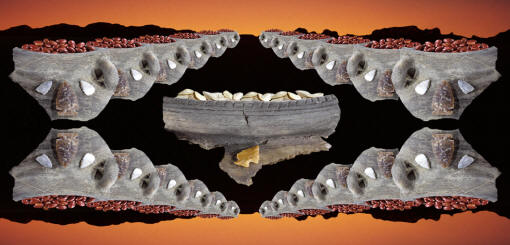|
"The Mitchell site is a
prehistoric village where farming people once lived. The site is located
on a bluff above Firesteel Creek---."---------1998,
"The Mitchell Prehistoric Indian Village Site," poster.
"The Indian Village (Mitchell
site) is a prehistoric archaeological
site that also includes a museum and archeodome."---------2011,
www.mitchellindianvillage.org, web site.
"The village (Mitchell
site) was built 1,000 years ago out
of wood and earth. The lodges had large upright posts and wattle and
daub walls supporting a roof likely covered with turf."---------2011,
www.mitchellindianvillage.org, web site.
"The Mitchell Prehistoric Indian Village is a very
special center as you will not only get to explore a 1,000 year-old
settlement, but also see how archaeologists go about reconstructing the
past when there are no written records." ---------2011,
www.mitchellindianvillage.org, web site.
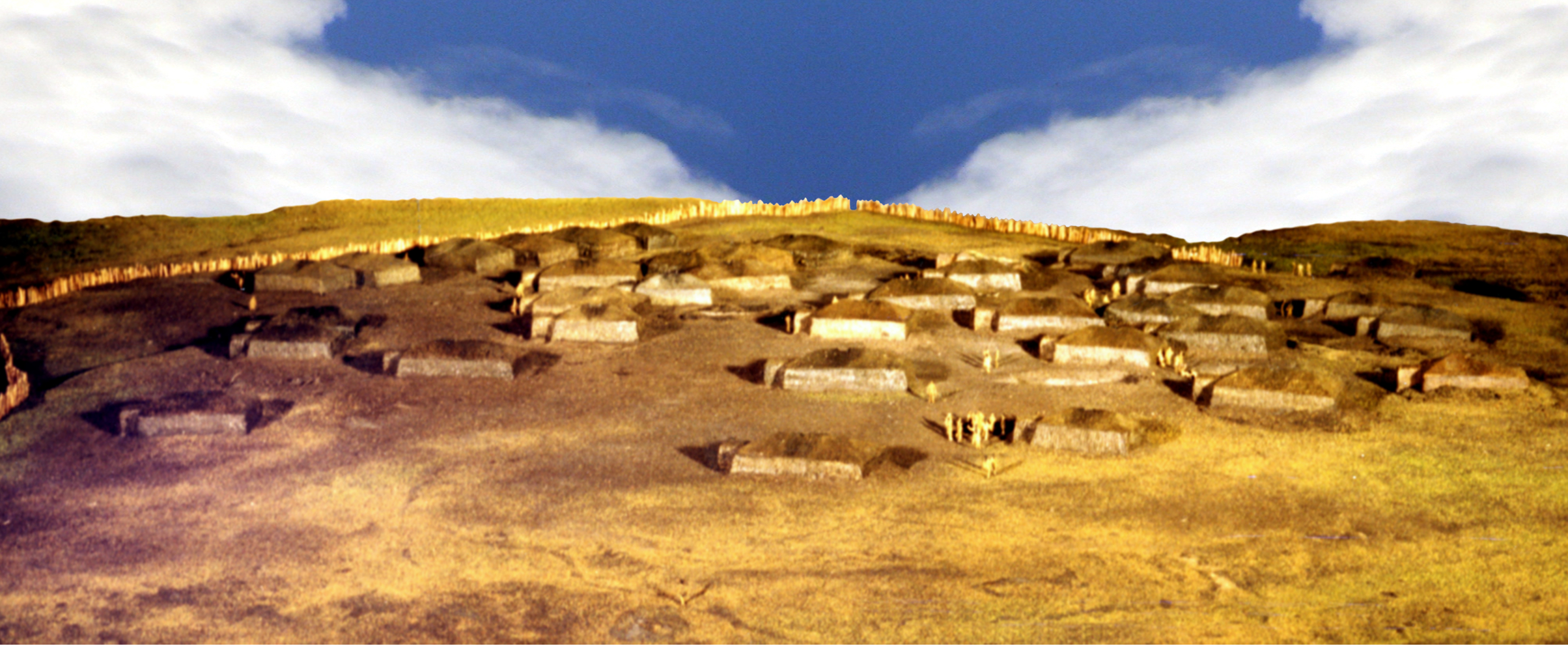
CLICK ON PICTURE FOR LARGER IMAGE
DIORAMA RECONSTRUCTION OF
THE MITCHELL PREHISTORIC INDIAN VILLAGE
This diorama shows how the Mitchell site may have
looked when the village began to expand. The palisade wall can be seen
along the outer parameter and the simple waddle and daub house
structures are spreading across the hillside. This diorama is one of the
exhibits on display in the
Boehnen Museum.

MITCHELL PREHISTORIC
INDIAN VILLAGE SITE
A.D. 1000
SOUTH DAKOTA
Most archaeological
sites disappear from the public eye after they've been excavated and the
data has been recorded and the artifacts numbered and stored away. Only
rarely are these unique locations preserved as archaeological parks
where people can go to see the artifacts and the excavated areas. At the
Mitchell site the subject is "prehistoric farmers and hunters" and
how they once lived. So, in this respect, the Mitchell Prehistoric
Indian Village Site is an exception. In some ways, the village has been
brought back to life.
|
|

CLICK ON PICTURE FOR LARGER IMAGE
BONE, CERAMIC, SHELL &
STONE ARTIFACTS
MITCHELL PREHISTORIC INDIAN VILLAGE SITE
A.D. 1000
SOUTH DAKOTA
All of the artifacts in this picture were found during the
excavation of the Mitchell Prehistoric Indian Village Site in South
Dakota. They date to approximately A.D. 1000. These are typical
examples of food processing, hunting and ornamental tools that were
in use by farming communities over a wide area of North America
during this period. They are made of bone, ceramic, shell and stone materials.
The artifacts in this picture include several decorated rim sherds
that were
once parts of bowls and jars that held and processed different types
of food. Several deer and bison bone tools are also represented in the form of bone awls, a serrated flesher tool,
fishhooks, a squash scrapper and a notched bone point. Several shell
ornaments mostly in the form of beads are illustrated and the
stone tools are represented by 34 arrow points, 3 perforators, 3
end-scrapers and 2 ground stone ungrooved axes (celts). |
|
|
The Mitchell site is located in southeastern South Dakota
near the town of Mitchell. The site is situated on a bluff above
Firesteel Creek near its confluence with the James River. The people who
once lived there are believed to have been the ancestors of the Mandan
who were settled along the Missouri River at the time of European
contact. They were also distant descendants of agricultural groups from
the east who once farmed the Mississippi River Valley. |
|
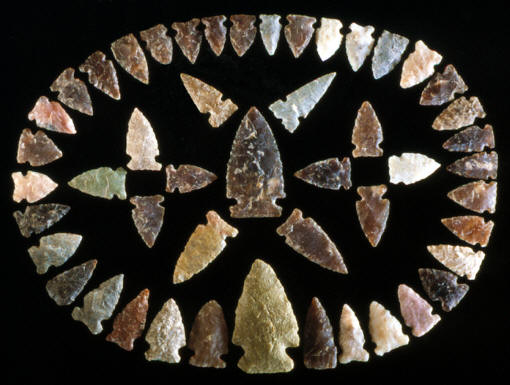
CLICK ON PICTURE FOR LARGER IMAGE
ARROW POINTS
MITCHELL PREHISTORIC INDIAN VILLAGE SITE
A.D. 1000
SOUTH DAKOTA
The Mitchell Prehistoric Indian
Village Site produced many arrow points. Most of these are
double-notched forms. They were mainly used to provide meat as
evidenced by the many bison and deer bones that are found on the
site. The point in the center is thin and very well made. It's one
of the best and longest examples found on the Mitchell site. It
measures 1 29/32 inches (4.8 cm) long. |
|
|
The people who once lived on the Mitchell site acquired their
food from many different sources. The discovery of food processing tools and carbonized seeds
suggest that these people were growing much of their food. Artifacts, such as
hoes and squash knives are also good indicators that they were farmers.
Various types of carbonized seeds and corn cobs show they were
growing corn, beans, squash, sunflowers and tobacco. |
|

CLICK ON PICTURE FOR LARGER IMAGE
SHELL ORNAMENTS
MITCHELL PREHISTORIC INDIAN VILLAGE SITE
A.D. 1000
SOUTH DAKOTA
This
picture shows some of the rare examples of shell artifacts that were
found on the Mitchell site. They were all made from freshwater
clams. The most common ornament (jewelry) found on late Stone Age
sites in North American are in the form of beads. The people who
once lived on the Mitchell site produced tubular and flat disc shell
beads. Several good examples can be seen in this picture. All have
been perforated for suspension except for six flat disc beads that
were not yet finished. Also pictured is a scraping tool that is made
of a large piece of shell that is serrated on one end. The
unfinished shell piece to the right of it appears to have been cut
into a human-like figure which may have eventually been finished
into a pendant. |
|
|
Some of the earliest accounts describing how
native American Indians were
planting their crops begin around 1623. Sagard reports, from this
period, that the Hurons were planting in round holes every two feet or
less about nine or ten grains of corn which they had previously
selected, culled and soaked for several days in water. He also reports
that they planted in the same place every year in the month of May.
Early accounts also describe various types of fertilizers that were
used. The Plymouth colonists were told to add fish to the old grounds.
It's also stated that the Iroquois manured their land. Lescarbot wrote
that the Virginia Indians and others enriched their fields with shells
and fish. |
|
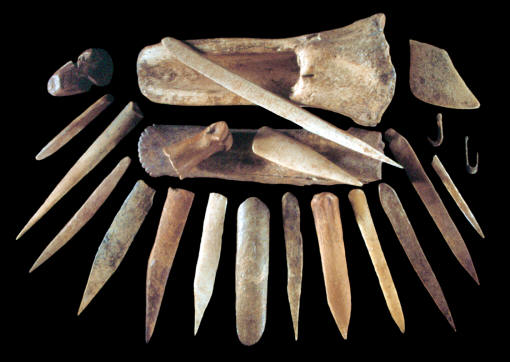
CLICK ON PICTURE FOR LARGER IMAGE
BONE TOOLS
MITCHELL PREHISTORIC INDIAN VILLAGE SITE
A.D. 1000
SOUTH DAKOTA
The Mitchell site produced many tools
that were made from bone. Most of the bone came from bison. The
hardness and toughness of this material is the reason it was used
for so many different kinds of tools and ornaments. Most of the
artifacts in this picture are represented by long narrow and pointed
awls that were made from the long bones of bison. Awls were mainly used
for piercing holes for various purposes such as sewing. Longer forms of these tools may also been
used as hair pins or as pins to hold down mats. The two largest bone artifacts in
this picture are bone fleshers. One is serrated on the end and the
other is smooth. Fleshers were used as scraping tools to scrape
animal hides. The bone artifact at top right is a squash knife that
was used to clean the seeds from inside squash. It was made from a
bison scapula. Squash knives were sometimes made from broken bone
hoes. The artifact at the top left appears to be a side-notched
point projectile point. But it's not a typical artifact so it may
also have been an ornament that was suspended like a pendant. The
artifact located just left of center is a perforated deer phalange.
It was made from the toe bone of a deer. Its exact use is unknown
but it may have been used as a game piece in the ring-and-pin game. The
two delicate fishhooks represent some of the more rare artifacts
found on the Mitchell site. These two examples were made from the
scapula of a bison. Rather than used singularly they may have been
used on trot lines which would have had many hooks placed along a
long central line. |
|
|
Early accounts describe agriculture as one of the main
sources of food for native American Indians in the eastern United
States. These reports come from early European explorers such as De
Soto, Champlain and La Salle. De Soto reported that all the tribes he
visited from the Florida peninsula to the western part of Arkansas were
cultivating maize (corn) and various other food plants. Jacques Cartier was the
first European to travel up the St. Lawrence River. He reported that the
Indians in the region of what is now Montreal cultivated the soil and he
commented; "They have good and large fields of corn." General Wayne
wrote in 1794 that; "The margins of these beautiful rivers, the Miami
(tribe) of the Lake and the Au Glaize (tribe), appear like one
continuous village for a number of miles, both above and below this
place. Nor have I ever before beheld such immense fields of corn in any
part of America from Canada to Florida." |
|
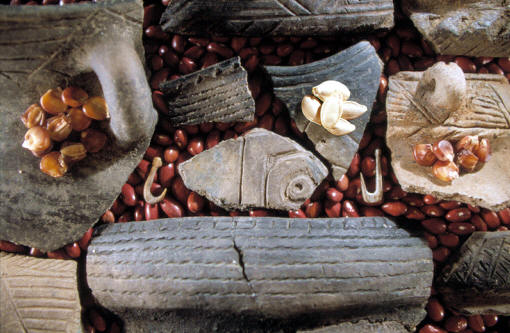
CLICK ON PICTURE FOR LARGER IMAGE
CERAMIC RIM SHERDS
MITCHELL PREHISTORIC INDIAN VILLAGE SITE
A.D. 1000
SOUTH DAKOTA
This picture shows several examples
of ceramic rim sherds and other broken pieces of bowls and jars that
were found on the Mitchell site. They show a few of the variety of
different designs. The two bone fishhooks were made from the scapula
of a bison. The beans, corn and squash seeds were grown in the
museum's primitive garden on the Mitchell Prehistoric Indian Village
site. |
|
|
Accounts that describe campaigns against Indian tribes also
show how exceptionally large their crops of corn were. In 1687 a report
describes the destruction of Iroquois corn, that was probably still on
the ear, by Denonville that is estimated to have been one million
bushels. The destruction is reported to have been against seven Indian
villages and to have taken seven days. Another attack against Iroquois
villages during the Revolutionary War by General Sullivan reports the
destruction of 160,000 bushels of corn and the cutting down of 1,500
apple trees in one orchard alone. |
|
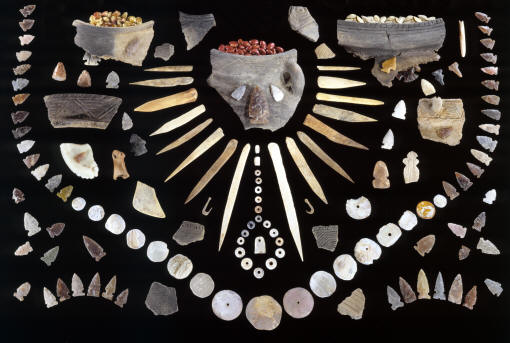
CLICK ON PICTURE FOR LARGER IMAGE
BONE, CERAMIC, SHELL &
STONE ARTIFACTS
MITCHELL PREHISTORIC INDIAN VILLAGE SITE
A.D. 1000
SOUTH DAKOTA
This picture shows
the lower half of a poster that was printed in 1998 and is available
from the Mitchell site's museum shop. The "Mitchell Prehistoric
Indian Village Site" poster shows 227 artifacts that were collected
over a period of at least thirty years. Most of these artifacts are
described in the picture descriptions above. |
|
|
The late Stone Age farming community site, known as the Mitchell
Prehistoric Indian Village site, dates to about A.D. 1000. The structures on
the site were built out of wood and earth. They were constructed with
poles set into the ground with basic wattle and daub walls. It's
estimated that the village was composed of approximately 80 of these
earth-lodge structures. The houses were rectangular in shape with an
average size of about 20 feet by 40 feet. |
|
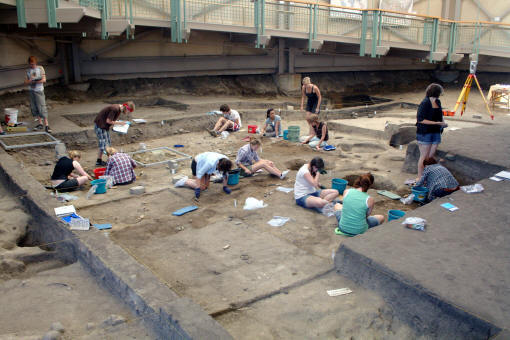
CLICK ON PICTURE FOR LARGER IMAGE
STUDENTS EXCAVATING INSIDE
THE
THOMSEN CENTER ARCHEODOME
MITCHELL PREHISTORIC INDIAN VILLAGE SITE
A.D. 1000
SOUTH DAKOTA
This picture shows Augustana College students excavating inside the
Thomsen Center Archeodome on the Mitchell site. The structure covers
a large area of the site where excavations will continue for many
years until a depth of approximately 13 feet or 4 meters is reached. |
|
|
The Mitchell site village was also fortified with a defensive
rampart that stretches for about two-thirds of its perimeter.
Excavations show that there was once a log palisade located inside a
deep and wide ditch. Evidence has shown that many other Mississippian
sites were also fortified with palisade walls to defend against raiding
parties. The first European explorers reported many fortified villages
with palisades. The stockade wall around the Cahokia Mounds site was the
largest. |
|

CLICK ON PICTURE FOR LARGER IMAGE
EXCAVATED SURFACE
MITCHELL PREHISTORIC INDIAN VILLAGE SITE
A.D. 1000
SOUTH DAKOTA
This picture shows an area of excavation inside
the Thomsen Center Archeodome on
the Mitchell site. Several post holes can be seen at the top indicating where
house structures once stood.
The Mitchell site houses were built out
of wood and earth. They were constructed with poles set into the
ground with basic wattle and daub walls. It's estimated that the
village was composed of approximately 80 of these earth-lodge
structures. The houses were rectangular in shape with an average
size of about 20 by 40 feet. |
|
|
The people who
once lived on the Mitchell site were hunting local game animals for food
and raw materials. Many of their tools were made from bison bones. Bison provided
a large quantity of meat plus an additional bonus of hides
and horns. Deer bones and the bones from smaller game
animals have also been found on the site. They were also harvesting
fish, clams and several varieties of waterfowl. |
|
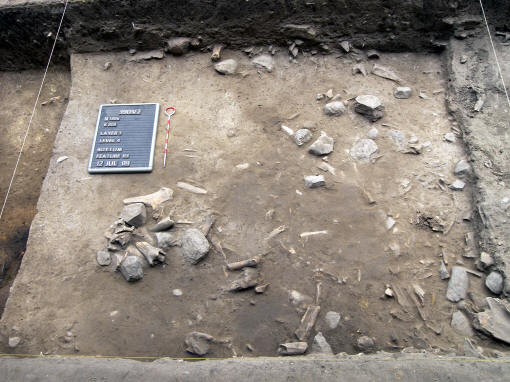
CLICK ON PICTURE FOR LARGER IMAGE
EXCAVATED SURFACE
MITCHELL PREHISTORIC INDIAN VILLAGE SITE
A.D. 1000
SOUTH DAKOTA
This excavated area
shows some of the typical surface debris dating to the time when the
Mitchell site was in use by people who were hunting bison and growing
corn, beans and squash. Many broken pieces of bison bones can be seen
along with large numbers of fractured rocks. |
|
|
Ancient cultures, in many parts of the world, began to
control plant species and domesticate animals as early as 10,000 years
ago. When people began to settle into year round villages the
additional food source from animal and plant domestication resulted in larger and more
concentrated populations. It's estimated that the Mitchell site once
held a population of somewhere between 500 to 800 people. |
|
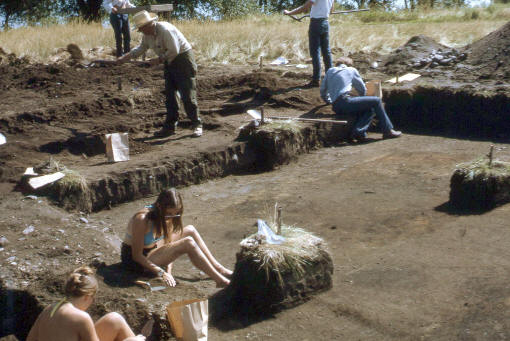
CLICK ON PICTURE FOR LARGER IMAGE
EARLY MITCHELL SITE
EXCAVATION--1970
HOUSE FEATURE 3
SOUTH DAKOTA
This picture was
taken in 1970 and it shows one of the early excavations in progress
on the Mitchell site. Students are excavating a house feature under
the direction of Dr. Robert Alex.
|
|
|
The excavation of the
Mitchell site produced a large number of artifacts. These artifacts are
in the form of flaked stone, ground stone, cut, shaped and polished bone
& shell and fire hardened shell tempered ceramic pots. The raw
materials from which they were made were all locally available. All of the bone and shell were
obtained from local food source animals such as bison & deer bone and clam
shells. The clay for their pots was also locally available. Various
types of cherts and pebbles were used for the
production of axes, projectile points, scrapers, perforators and other
tools. Most of these stones were available from local stream
cuts and river banks. |
|
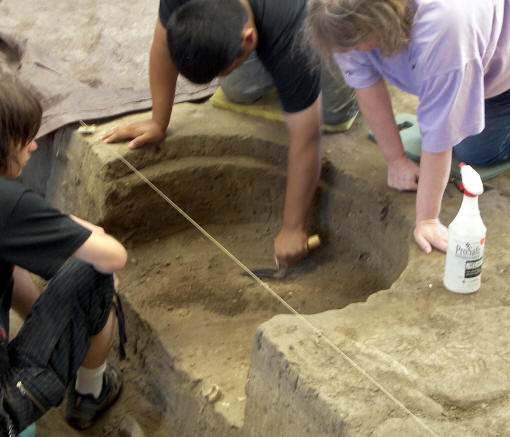
STUDENTS EXCAVATING A FOOD CACHE PIT
INSIDE THE
THOMSEN CENTER ARCHEODOME
MITCHELL PREHISTORIC INDIAN VILLAGE SITE
A.D. 1000
SOUTH DAKOTA
These Augustana Anthropology students are excavating a food cash pit
feature inside the Thomsen Center Archeodome. Pits like this one
were used to store grain and other types of food. |
|
|
The Mitchell site
is now a National Register and a National Historic Landmark property and two modern
interpretive centers have been built. The Boehnen Museum has a full size
replica of an earthlodge along with many other exhibits and artifacts.
The other structure is the Thomsen Center Archeodome which is built over
a large area of excavation. The Mitchell Prehistoric Indian Village Site
invites anyone who wants to see and learn more about a this 1,000
year old farming community village site to stop in for a visit if you
are in the area. More current and updated information can be found on their web site at
www.mitchellindianvillage.org |
|
"REFERENCES"
1912,
Hodge, Frederick Webb,
"Handbook Of American Indians North Of Mexico," Agriculture,
pp. 24-27.
1988, Tattersall, Delson & Couvering, "Encyclopedia Of Human
Evolution And Prehistory," Domestication, pp. 160-161.
1998, Bostrom, Peter A., "The Mitchell Prehistoric Indian Village
Site," poster.
2011,
www.mitchellindianvillage.org web site
Personal Communication with Adrian Hannus
|
|
RECENT
LISTINGS HOME
ORDERING |

